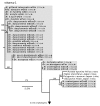Diversity and phylogenetic relationships of Wolbachia in Drosophila and other native Hawaiian insects
- PMID: 22878693
- PMCID: PMC3519662
- DOI: 10.4161/fly.21161
Diversity and phylogenetic relationships of Wolbachia in Drosophila and other native Hawaiian insects
Abstract
Wolbachia is a genus of parasitic alphaproteobacteria found in arthropods and nematodes, and represents on of the most common, widespread endosymbionts known. Wolbachia affects a variety of reproductive functions in its host (e.g., male killing, cytoplasmic incompatibility, parthenogenesis), which have the potential to dramatically impact host evolution and species formation. Here, we present the first broad-scale study to screen natural populations of native Hawaiian insects for Wolbachia, focusing on the endemic Diptera. Results indicate that Wolbachia infects native Hawaiian taxa, with alleles spanning phylogenetic supergroups, A and B. The overall frequency of Wolbachia incidene in Hawaiian insects was 14%. The incidence of infection in native Hawaiian Diptera was 11% for individuals and 12% for all species screened. Wolbachia was not detected in two large, widespread Hawaiian dipteran families-Dolichopodidae (44 spp screened) and Limoniidae (12 spp screened). Incidence of infection within endemic Hawaiian lineages that carry Wolbachia was 18% in Drosophilidae species, 25% in Caliphoridae species, > 90% in Nesophrosyne species, 20% in Drosophila dasycnemia and 100% in Nesophrosyne craterigena. Twenty unique alleles were recovered in this study, of which 18 are newly recorded. Screening of endemic populations of D. dasycnemia across Hawaii Island revealed 4 unique alleles. Phylogenetic relationships and allele diversity provide evidence for horizontal transfer of Wolbachia among Hawaiian arthropod lineages.
Figures




References
Publication types
MeSH terms
LinkOut - more resources
Full Text Sources
Molecular Biology Databases
Miscellaneous
